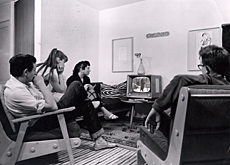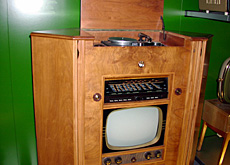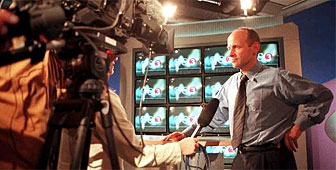Exhibition traces the roots of Swiss television

The Museum of Communication in Bern is inviting visitors into “sitting rooms” looking back at 50 years of television in Switzerland.
Each room has been recreated to bring to life viewing habits over the years in the country’s German, French and Italian cultural regions.
But “Prime Time” – as the exhibition is called – goes much further than turning the spotlight on the viewers, exploring the cultural history of the medium.
It includes a “boulevard” of shop windows displaying typical consumer goods of the past five decades, photographs of Swiss television celebrities and relics of the technical equipment to which they were subjected.
“Subjected” is an appropriate word in this context, because the early television studios were cramped and overheated, with powerful lighting and huge cameras, which dwarf their modern-day colour counterparts.
Conceived in collaboration with the Swiss Broadcasting Corporation, the exhibition examines the social influence of television, including its influence on young viewers.
Josefa Haas, the SBC’s head of communications, says the medium survived a certain amount of initial mistrust and reached maturity “by proving its seriousness”.
Early broadcasts
Swiss television went on air in Zurich in 1953 with broadcasts for the German-language region. The first programmes featured news, aired only on Monday, Wednesday and Friday evenings.
A year later, viewers were treated to a broader programme range, including operettas and short documentaries on art, nature and geography.
Also in 1954, television in the French-language region was born in Geneva; an Italian service followed three years later.
Barbara Wenk, one of the exhibition organisers, told swissinfo that one of the main challenges faced by her and her colleagues was the task of covering each of the three main linguistic regions.
“That’s why we chose three different sitting rooms, with families watching television in the privacy of their homes,” she said.
Spirit of improvisation
Wenk also recalled the spirit of improvisation during television’s early days, when secretaries suddenly found themselves presenting programmes.
She says one of her favourite exhibits is a costume made by a tailor recruited in a restaurant and obliged to work on a tiny budget.
Typical contemporary programmes spanning information, entertainment and sport are replayed on screens in each room.
There are also computer stations where visitors can tune in to a host of programmes from Swiss television history.
This is a multi-faceted exhibition, reflecting the growing power of the medium since the 1950s. It shows how the television set – the early ones were much smaller than today’s – became a central feature of nearly every Swiss sitting room.
Antique cameras, recording equipment and editing machines complete the nostalgic picture. A tour of the exhibition ends with a room flooded with images from 24 present-day satellite channels.
The exhibition ends on July 25, 2004.
swissinfo, Richard Dawson
The first Swiss television pictures were broadcast from Zurich on July 20, 1953.
Initially programmes were only broadcast on Monday, Wednesday and Friday evenings.
In 1954 they were transmitted every day except Tuesday.
Also in 1954 the first French-language programme in Switzerland was broadcast from Geneva.
An Italian channel was inaugurated in 1958.
“Prime Time” was organised by the museum in collaboration with the Swiss Broadcasting Corporation.

In compliance with the JTI standards
More: SWI swissinfo.ch certified by the Journalism Trust Initiative


You can find an overview of ongoing debates with our journalists here. Please join us!
If you want to start a conversation about a topic raised in this article or want to report factual errors, email us at english@swissinfo.ch.